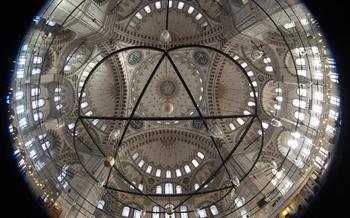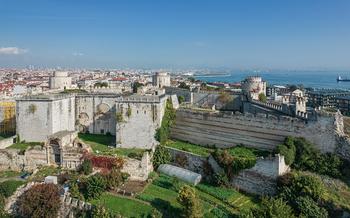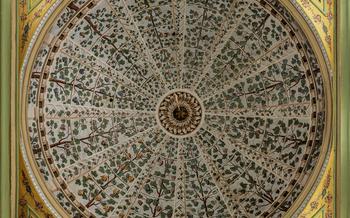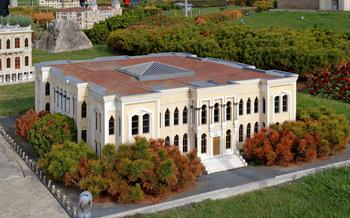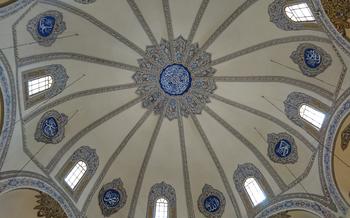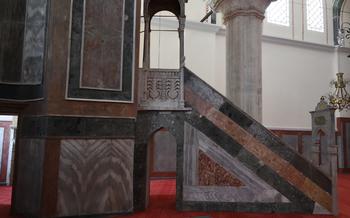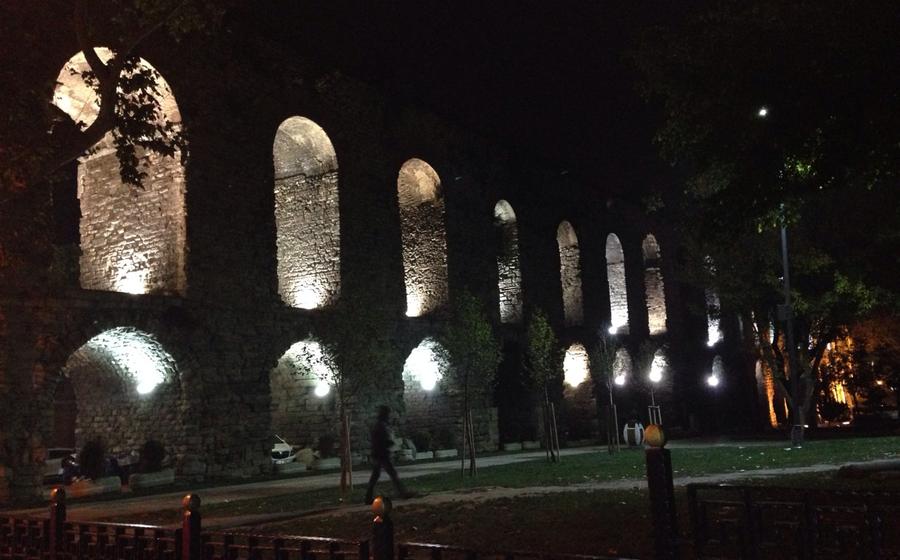
Aqueduct of Valens
- Historical Significance: A Testament to Roman Engineering
- Architectural Marvel
- Location and Accessibility
- Exploring the Aqueduct
- Historical Context
- Restoration and Preservation
- Legends and Folklore
- Local Cuisine:
- Photography Opportunities
- Visiting Tips:
- Historical Figures
- Cultural Significance
- Sustainability and Eco-Tourism
- Insider Tip:
Historical Significance: A Testament to Roman Engineering
The Aqueduct of Valens stands as a testament to the extraordinary engineering prowess of the ancient Romans. Built in the 4th century AD during the reign of Emperor Valens, this awe-inspiring structure played a crucial role in supplying water to Constantinople, the capital of the Byzantine Empire. Its remarkable resilience is evident from its survival through numerous earthquakes and invasions over the centuries. As you stand before this architectural marvel, you can't help but be filled with admiration for the ingenuity and skill of the Roman builders who created this enduring masterpiece.
Architectural Marvel
The Aqueduct of Valens stands as a testament to Roman engineering prowess, showcasing an impressive double-arched structure that spans over 600 meters. Constructed using brick and stone, a technique adopted by the Romans, the aqueduct demonstrates their mastery of building materials and construction methods. The innovative use of buttresses provides support and stability to the structure, ensuring its resilience over time. Unique design features, such as arches of varying sizes and decorative elements, add to the aqueduct's visual appeal and architectural significance. Its enduring presence, despite the passage of time and various challenges, speaks volumes about the skill and ingenuity of the ancient Roman builders.
Location and Accessibility
The Aqueduct of Valens is located in the Fatih district of Istanbul, on Atatürk Boulevard, near the intersection with Fevzipaşa Caddesi. It is easily accessible by public transportation, with the nearest tram stop (Beyazıt-Kapalıçarşı) just a short walk away. Visitors can also take the Marmaray train to the Sirkeci station and then walk or take a short taxi ride.
For those exploring the city on foot, the aqueduct is within walking distance from popular tourist spots such as the Grand Bazaar, the Süleymaniye Mosque, and the Topkapı Palace. The walk offers a great opportunity to soak in the bustling atmosphere of Istanbul's historic center. A map or directions can be found online or at the tourist information centers in the city.
Exploring the Aqueduct
To fully appreciate the grandeur of the Aqueduct of Valens, take some time to explore its path and capture its beauty from different perspectives. The best angles for photography are from a distance, where you can frame the entire structure against the Istanbul skyline. For a closer look, stroll along the aqueduct's path, where you'll find unique vantage points and photo opportunities. If you're feeling adventurous, climb the steps to the top of the aqueduct for panoramic city views that will take your breath away. To avoid crowds and harsh sunlight, plan your visit early in the morning or late in the afternoon, when the light is softer and the crowds are thinner.
Historical Context
The construction of the Aqueduct of Valens was a pivotal moment in the development of ancient Constantinople. In a city where access to clean water was crucial, the aqueduct played a vital role in sustaining a growing population and supporting urban expansion. Its significance extended beyond water supply; it was a testament to the ingenuity and engineering prowess of the Byzantine Empire.
The Byzantine Empire, a continuation of the Roman Empire in the East, placed great emphasis on infrastructure and public works. The aqueduct, named after Emperor Valens who commissioned its construction in the 4th century AD, was a testament to their commitment to urban planning and development. It formed part of a complex network of aqueducts that supplied water to Constantinople, ensuring a reliable source for domestic, industrial, and public use.
The aqueduct's construction also reflected the Byzantine Empire's architectural achievements. The use of brick and stone, a technique adopted from the Romans, demonstrated their mastery of building materials and construction methods. The innovative use of buttresses provided structural support, ensuring the aqueduct's resilience against earthquakes and invasions that ravaged the city throughout history.
By examining the Aqueduct of Valens, we gain insights into the Byzantine Empire's dedication to urban infrastructure, engineering prowess, and the importance of water management in shaping the development of ancient Constantinople.
Restoration and Preservation
The Aqueduct of Valens has undergone several restoration and preservation efforts throughout history, ensuring its continued existence as a testament to Roman engineering. In recent years, the Turkish government has played a significant role in preserving the aqueduct, recognizing its historical and cultural value. One of the most notable restoration projects was initiated in 2012, focusing on strengthening the structure and addressing issues related to erosion and decay. The project involved meticulous cleaning, repair of damaged sections, and the addition of support structures to enhance its stability. Ongoing monitoring and maintenance efforts are carried out to ensure the aqueduct's longevity and resilience against the challenges posed by time and environmental factors. These efforts reflect the commitment to preserving Istanbul's rich heritage and ensuring that the Aqueduct of Valens continues to inspire and awe visitors for generations to come.
Legends and Folklore
Beyond its historical significance, the Aqueduct of Valens is steeped in local legends and folklore that add a touch of mystery and intrigue to its presence. One popular tale tells of hidden treasures buried beneath the aqueduct, waiting to be discovered by a lucky adventurer. Another legend speaks of ghostly apparitions that haunt the aqueduct's arches at night, their presence a reminder of the structure's long and storied past. These legends reflect the rich storytelling traditions of Istanbul, where history and myth intertwine to create a captivating tapestry of narratives. Visitors are encouraged to explore the local culture and traditions through these stories, adding a layer of enchantment to their visit to the Aqueduct of Valens.
Local Cuisine:
Indulge in the vibrant culinary scene that surrounds the Aqueduct of Valens, where tantalizing aromas fill the air. Savor the flavors of traditional Turkish cuisine at nearby restaurants or street food stalls. Delight in succulent kebabs, döner, or pide, each bursting with authentic spices and grilled to perfection. Treat your sweet tooth to Turkish coffee or tea, accompanied by delectable Turkish delights or baklava, a perfect way to end your culinary exploration. For an authentic experience, venture into the local eateries and immerse yourself in the warm hospitality and delicious offerings that Istanbul has to offer.
Photography Opportunities
The Aqueduct of Valens presents a unique visual spectacle for photography enthusiasts. With its towering arches, intricate stonework, and the backdrop of Istanbul's cityscape, it offers a variety of captivating shots. Experiment with different angles to capture the aqueduct's grandeur, from close-up details to panoramic vistas. Utilize natural lighting conditions to your advantage, as the golden hues of sunrise or sunset cast a warm glow on the ancient structure. Embrace long exposure photography to capture the aqueduct's movement and the bustling city life around it. Share your stunning captures on social media, using relevant hashtags like #AqueductOfValens or #Istanbul, to connect with fellow photographers and inspire others to explore this historical gem.
Visiting Tips:
For a hassle-free visit to the Aqueduct of Valens, consider these practical tips:
-
Comfortable Footwear: Opt for comfortable walking shoes, as the area around the aqueduct features uneven terrain and cobblestone streets.
-
Hydration and Sun Protection: Bring a bottle of water and apply sunscreen, especially during hot weather, as there is limited shade along the aqueduct.
-
Accessibility: The site is generally accessible, but visitors with disabilities or mobility issues may encounter some challenges due to uneven surfaces and steps. Consider exploring accessible routes or seeking assistance if needed.
-
Opening Hours and Fees: The Aqueduct of Valens is accessible 24 hours a day and admission is free of charge.
-
Guided Tours: While guided tours are not mandatory, they can provide valuable insights into the history and significance of the aqueduct. Check with local tour operators for availability and pricing.
Historical Figures
The Aqueduct of Valens is closely linked to several notable historical figures who played a significant role in its construction and the development of Constantinople. Emperor Valens, who ruled the Eastern Roman Empire from 364 to 378 AD, commissioned the aqueduct as part of his ambitious urban renewal projects. Under his patronage, the aqueduct was designed and built by skilled architects and engineers, whose names have been lost to history.
One notable figure associated with the aqueduct is Frontinus, a Roman water commissioner and engineer who lived in the 1st century AD. Although not directly involved in the construction of the Aqueduct of Valens, his writings on water management and aqueduct design greatly influenced Roman engineering practices. His treatise, "De Aquaeductu," provided valuable insights into the principles of aqueduct construction, which were likely adopted by the builders of the Aqueduct of Valens.
Throughout history, the aqueduct has witnessed countless events and stories involving various historical figures. From Byzantine emperors to Ottoman sultans, the aqueduct has served as a backdrop to the rich tapestry of Istanbul's history. Its enduring presence reminds us of the significant contributions made by these individuals to the city's development and legacy.
Cultural Significance
The Aqueduct of Valens holds immense cultural significance as a symbol of Istanbul's rich history and heritage. Its enduring presence has inspired artists, writers, and storytellers throughout the ages, weaving it into the fabric of the city's cultural identity. The aqueduct has been depicted in paintings, sketches, and photographs, capturing its architectural grandeur and historical significance. In local folklore, it is a source of legends and tales, passed down from generation to generation, adding a touch of mystery and intrigue to its allure. As a gathering place and landmark, the aqueduct fosters a sense of community and belonging among locals and visitors alike. Its iconic silhouette serves as a reminder of Istanbul's resilience and the enduring legacy of the Byzantine Empire. Visitors are encouraged to delve into the cultural significance of the aqueduct, appreciating its role in shaping the city's unique character and narrative.
Sustainability and Eco-Tourism
As responsible travelers, it is essential to prioritize sustainability and eco-tourism when visiting the Aqueduct of Valens and its surroundings. Respect the historical significance of the site by avoiding any damage or graffiti. Embrace eco-friendly transportation options, such as walking, cycling, or utilizing the efficient public transportation system, to minimize carbon emissions and contribute to a greener Istanbul. Support local businesses and initiatives that prioritize sustainability, ensuring that your visit positively impacts the local economy and community. Together, we can preserve the beauty and heritage of the Aqueduct of Valens while promoting responsible tourism practices that benefit both the environment and the local population.
Insider Tip:
For a unique perspective of the Aqueduct of Valens, venture into the narrow streets of the Fatih neighborhood and seek out the secluded spot known as the "Hidden Garden." Nestled amidst charming Ottoman-era houses, this tranquil oasis offers a breathtaking view of the aqueduct's majestic arches framed by lush greenery. Enjoy a moment of peace as you sip on traditional Turkish coffee from a nearby café and soak in the timeless beauty of this architectural marvel.
